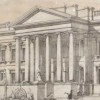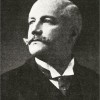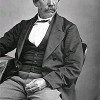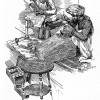
Jason R. Rudy, “On Literary Melbourne: Poetry in the Colony, ca. 1854”
Few in the mid-nineteenth century would have imagined the British colonies in Australia as spaces for poetic composition, and yet reproducing culture abroad was crucial to the British colonial project. This essay explores some of the challenges faced by poets in colonial Melbourne, a city at first more interested in gold digging than literary composition.

Erik Simpson, “On Corinne, Or Italy”
Germaine de Staël’s Corinne, Or Italy was published in French in 1807 and was quickly translated into English. It became a touchstone for nineteenth-century conceptions of women’s creativity and the life of the woman writer, as well as an important formulation of analogies between models of artistic creation and political systems. The novel’s portrayal of Italian improvisers also helped produce the modern usage of “improvisation” and related terms in English.

Sarah Winter, “On the Morant Bay Rebellion in Jamaica and the Governor Eyre-George William Gordon Controversy, 1865-70”
In the aftermath of the Morant Bay rebellion that broke out on 11 October 1865, the Governor of Jamaica, Edward John Eyre, ordered extensive and harsh reprisals against Black Jamaicans in the county of Surrey under a period of martial law lasting from 13 October to 13 November. Eyre’s actions provoked widespread controversy among intellectuals, politicians, and the general public in Britain. The Jamaica Committee was organized in December 1865 to monitor the government’s response. After a Royal Commission investigation of the rebellion and its aftermath, Eyre was removed from his post and recalled by the Colonial Office. Led by John Stuart Mill, the Jamaica Committee undertook three attempts between 1866-68 to prosecute Eyre for murder and abuse of power for his role in sanctioning the court martial and execution of George William Gordon, a former slave and Jamaican politician who was accused of fomenting the rebellion. Repeatedly, English grand juries refused to indict Eyre or convict his subordinates. The question of the constitutionality of martial law raised by the Jamaica Committee’s prosecutions implied that taking sides for or against Eyre’s actions was fundamentally an expression of political views about the legal limitations on the use of force in imperial governance. Defending the importance of the constitutional principles at stake in the Jamaica Committee’s unsuccessful prosecutions of Eyre, Mill articulated the duty to uphold the rule of law as a fundamental principle of modern citizenship. The question of the extent of Gordon’s rights as a “fellow-citizen” within the British Empire, however, remained unresolved.

Dane Kennedy, “The Search for the Nile”
This essay examines the social and cultural contexts that informed British explorers’ efforts to discover the source of the Nile. It highlights the relationship of these expeditions to existing systems of trade and power in East Africa, British imperial interests in the region, and the development of a celebrity culture in Britain.

Stefanie Markovits, “On the Crimean War and the Charge of the Light Brigade”
The Crimean War sheds light on mid-Victorian perceptions of class and national identity. As literary and visual representations of the war reveal, reactions to this conflict were both more nuanced and more ambivalent than our preconceptions about Victorian jingoism might anticipate. The charge of the Light Brigade at Balaklava captures the ironies of a high Victorian military spectacle that frequently seemed to confuse the patriotic expectations of its home-front audience. A new form of heroism grew out of the bewildering experience of the Light Brigade’s defeat—and a new sense of national identity that was based in part on this new heroism.

Brenda Assael, “On Dinners and Diners and Restaurant Culture in Late Nineteenth-Century London”
Lieutenant Colonel Nathaniel Newnham-Davis’s Dinners and Diners, published in 1899, provides a lively and valuable introduction to the restaurant in late nineteenth-century London, an aspect of Victorian metropolitan experience that has been largely overlooked by historians. This article uses Dinners and Diners to explore three aspects of Victorian metropolitan culture that are dramatized through public eating: first, the centrality of cosmopolitanism; second, the relationship between changing gender roles and new forms of urban sociability; and third, the significance of the theater and theatricality in late-Victorian culture.

Alison Chapman, “On Il Risorgimento”
“Il Risorgimento”, the popular term for Italian Unification, is a complex and contentious term that connects two highly symbolic moments in the peninsula’s history: the crowning of Napoleon as King of Italy in 1805 to the 1861 unification of most of Italy with the military and diplomatic assistance of his nephew Napoleon III and King Victor Emanuel of Piedmont. The complex and contradictory set of myths that insist on the “beautiful legend” of the Risorgimento cover over the very difficulty and controversy of the notion of Italy itself.

Matthew Rubery, “On Henry Morton Stanley’s Search for Dr. Livingstone, 1871-72”
The meeting between Henry Morton Stanley and Dr. David Livingstone in Africa was one of the most sensational news stories of the nineteenth century. Stanley’s greeting, “Dr. Livingstone, I presume?” is still a well known phrase. The Scottish missionary had been out of contact for several years when an American newspaper sent its correspondent to search for him. The meeting turned public attention to the African slave trade and was a pivotal moment in the relationship among the United States, Europe, and Africa.

Gillen D’Arcy Wood, “1816, The Year without a Summer”
The so-called “Year Without a Summer”—1816—belongs to a three-year period of severe climate deterioration of global scope caused by the eruption of Mt. Tambora in Indonesia in April, 1815. With plummeting temperatures, and disruption to major weather systems, human communities across the globe faced crop failures, epidemic disease, and civil unrest on a catastrophic scale. In cultural terms, the dreary summer of 1816 is best known as the setting for Mary Shelley’s writing of Frankenstein, a novel whose iconic Creature offers a figure for the millions of hungry and dispossessed of Europe during the protracted climate emergency that followed Tambora’s eruption.

Aviva Briefel, “On the 1886 Colonial and Indian Exhibition”
This essay explores the 1886 Colonial and Indian Exhibition, focusing specifically on its unprecedented display of 34 Indian artisans. It contextualizes this display in relation to Victorian discourses that lamented the disappearance of the British working body through mechanization, and that conflated the authenticity of South Asian crafts with the presence of “genuine” Indian bodies.
